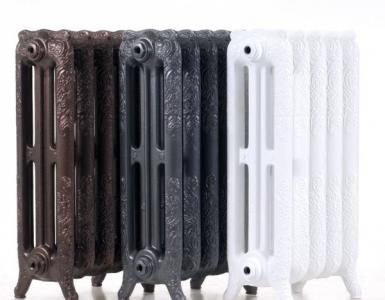Installing a washing machine in the bathroom. Cutting into a plastic pipe. Installation of a special siphon with a non-return valve
To clearly imagine how to connect washing machine, you must carefully read the instructions attached to it. All operations, from the removal of the package to the filling with water for the first wash, must be carried out clearly according to the rules. More clearly, the process of connecting to all communications is described in our article.
Suitable place for washing machine installation
Be sure to remember that correct installation washing machine automatic - this is the guarantee of its trouble-free and safe operation.
Variants of accommodation of home appliances can be different:
- It is considered standard to place a washing machine in the bathroom.

- Recently, this household appliance is increasingly placed in the kitchen, as it is convenient, and is also associated with a small area of bathrooms in old houses.
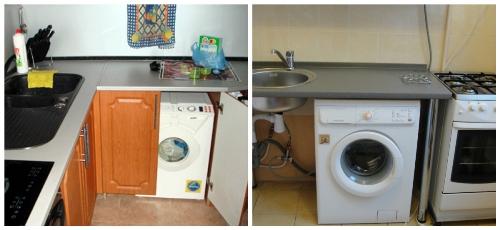
- Solving the problem of how to properly connect a washing machine, sometimes use an unusual installation option - in the hallway. If the hallway space allows the arrangement of the unit and it is possible to connect to the nearby communications, then this option can be quite ergonomic.
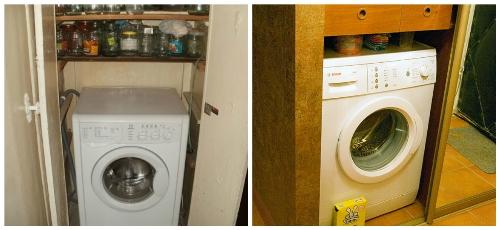
Stages of washing machine installation
Preparing for installation
After the installation site has been determined and the packaging has been removed, the transportation parts (bolts, staples and bars) are removed, as well as fastening elements that fix the rotating parts of the machine during transport. When the transport bolts are unscrewed, the tank of the machine hangs on the springs. This position is the normal operating state of the tank. Before connecting the machine machine, the remaining holes after screwing the bolt holes are covered with plastic plugs.
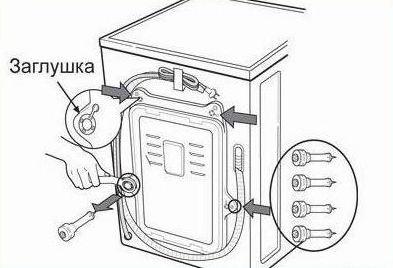
Advice from a professional:If the machine is switched on before all the transport parts are removed, the drum of the washing machine can be damaged, and the machine can then completely fail.
Connection to sewage
The connection of the machine to the drainage communications must take place taking into account the following features:
- Machines that do not have a special check valve that passes water in only one direction can not be installed without taking into account the level limitation (the manufacturer must specify the minimum and maximum value), on which the outlet hose (nozzle) should be located.
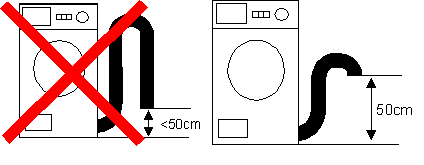
- Before you connect the drain of the washing machine, you must purchase an additional siphon to connect the sewage system to the sewer pipe. The hose of the machine is securely connected to the water drainage system from the sink. With this connection option, water leakage is excluded.
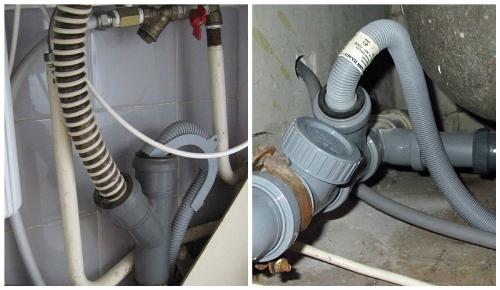
- Sometimes the drain pipe is fixed on the side of the tub or sink. However, such a method is not sufficiently reliable and safe, because if you accidentally hook the hose, the water will begin to flow to the floor.
Advice from a professional:The best way to connect a washing machine to a sewer is to perform a stationary drain of water. In this case, you will not have to worry about the correct position of the temporarily installed hoses - when the connection is stationary, reliability is guaranteed.
- After connecting, check whether the nozzle is straightened along the entire length (without kinks). It is rigidly fixed at a level of 80 cm from the floor on the back of the machine. To connect the drain hoses using adapters with clamps.
Water connection
Connect to water supply system is carried out as follows.
To perform this operation, use flexible hoses with a ¾-in. Diameter. If necessary, the hose is made longer by sealing the joints of the parts using cuffs (rubber gaskets).
Consider how to connect a washing machine yourself, using a separate valve:
- At a certain point in the water pipe, thread the thread and, using the appropriate fasteners, install a valve. After each wash, the water supply is completely blocked.
- It is recommended to install a protective filter mesh to prevent mechanical particles from entering the drum of the machine. The filter is periodically cleaned.
Advice from a professional:Connection to the water pipe is made with mandatory application stop valves, using ball valves to switch off the consumer if necessary.
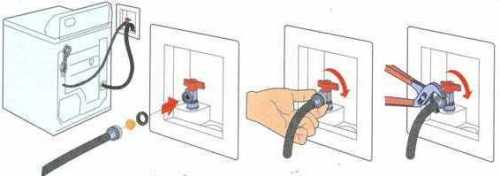
- For water supply, either ready-made bends to the flushing tank or to the mixer are used, connecting pipelines through tees, or mounting pipes and drifts to create individual points for the intake of liquid.
- It is necessary to use a relatively long hose. In this case, before each washing, unscrew the hose of the mixer and connect the filler pipe of the machine.
Now consider how to properly connect the machine to the water supply through a water mixer:
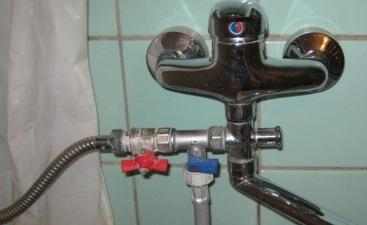
- Such a method of connection to water supply is possible, but it is used as a temporary option, allowing fast connection (no more than 2 minutes).
- In addition, in this case the machine is reliably protected from running water at the time when it does not perform the work, in connection with the disconnection of the inlet hose.
Aligning the position of the washing machine with a level
This stage of connection is necessary in order to minimize the level of vibration. In case of uneven flooring, the position of the washing machine is leveled using adjustable feet. In this case, the insertion of linoleum, wood and other materials is not recommended.
Then check the stability of the machine, lightly pressing on the corners of the machine on its upper surface. If the machine is tilted when pressed, it is necessary to adjust the position of the legs again.
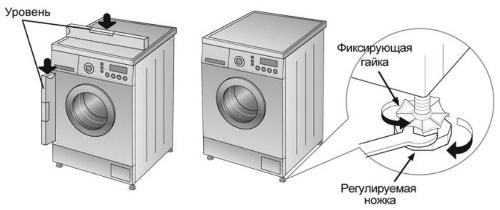
Electrical connection
All works connected to electricity are performed according to the following scheme:
Checking the operation of the unit in all modes
After the work is finished, it is worth checking the correctness of the installation in accordance with the list below:
- The tank should be typed in a short time to a certain point.
- Leaks should not be.
- The drum must rotate.
- The water is heated after 5-7 minutes. after the water stopped typing.
- After the end of washing, the sink should work normally.
- The spinning system must function.
- Foreign sounds should not be present when the machine is running.
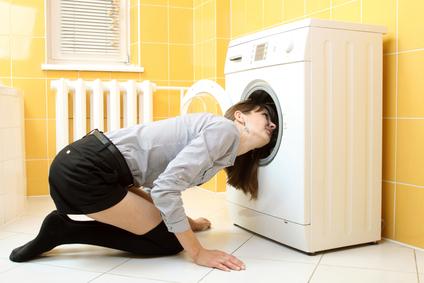
Since you can connect the washing machine by yourself, detailed instructions are attached to each washing machine. Before starting the installation, it must be carefully studied in order to take into account the specific features of your model. Thus, you can approach the solution of the problem with all responsibility.
Find a ribbed washing board and a basin with soapy water in a modern house is problematic. These devices for hand washing everywhere have become a rarity. Now all the housewives use an electric typewriter. However, the independent connection of the washing machine to the sewage system, the water supply and, of course, the power supply - that is still a puzzle. It is necessary to choose the right place for this important unit and correctly communicate to it. Otherwise, "Stiralka" can be used only as a large bedside table.
The model of household appliances for washing is selected, payment is made. And here it is delivered. So what is next? Well, when its connection is included in the cost. Otherwise, you have to do everything yourself and puzzle over how to connect the washing machine to the sewer and water pipes.
Washing machine is the norm of modern dwelling
But first you need to find a place for it - it can be:
- The angle in the bathroom.
- Space in the kitchen near the sink and dishwasher.
Sometimes the machine is installed in the hallway, under the stairs, in the pantry or basement. But these options are associated with additional difficulties in connection.
Next to the equipment there must be pipelines with cold water and sewerage. And they are usually located in kitchens and bathrooms. In other rooms, these pipes will have to be laid in addition, which is expensive and not very practical.
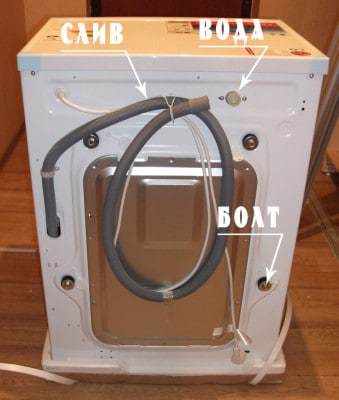
Washing machine: rear view
Standard drain hose, complete with a machine, has a length of up to 3 meters. It should be extended only as a last resort. The pump that pumps the water is designed for this particular meter. If the drainage is made too long, the pump can not stand and burn.
Another nuance of choosing the location of the washing machine is a floor covering. The floor must be made of ceramic tiles. When working, the spinning drum of the " strong vibration. Linoleum, parquet or laminate will quickly deteriorate.
Advice! During washing and spinning, the washing machine vibrates. The floor covering must be flat and firm. Ideal - floor tiles made of ceramic or porcelain stoneware.
Picking up a place, you can unpack a miracle technique. The main nuance here is the locking screws. They for the time of transportation fix the working drum so that it does not hang inside and could not be damaged. You can not turn on the machine until the stoppers are unscrewed, this will inevitably lead to breakage.
It remains to adjust the level of the legs, so that the technician stands smoothly. And you can connect the washing machine to the sewer and water.
Options for plugging the sewer to the sewage system
There are several ways to organize the drainage of water from the washing machine. Each of them has its own merits and nuances. The choice of the connection option depends on the specific features of the location of the pipelines and the wishes of the owner.
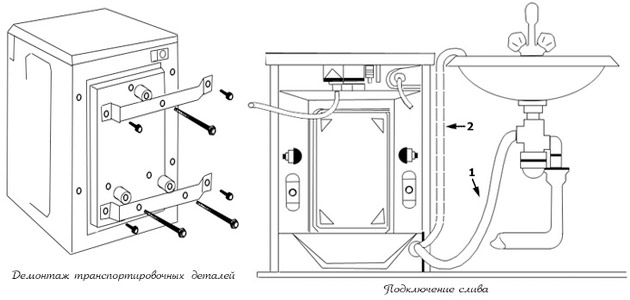
Organize the drain from the machine can be in several ways
To connect the washing machine to the sewer you can:
- Fixing the drain hose to the edge of the toilet bowl or bath.
- By connecting the sink to the usual siphon of the sink.
- By connecting the drainage pipe with a special siphon.
- Direct connection to the sewer pipe.
If the skills and desire to mount something is not, just fix the drain hose on the side of the bath. For this purpose, there is a special hook in the machine-tool set. But this sleeve is short and lengthen it is not recommended. Otherwise, you can burn the pump.
Important nuance!! If the sink is organized in a bath, then after each washing it will have to be washed. Merged from the machine water necessarily leave on the enamel dirty stains.
When using the hook, special attention should be given to the reliability of its attachment. If he falls from the side of the bath and does not notice it in time, the flood will be noble. For a cycle of operation the standard device pumps from 30 to 100 liters of water. All of them must go to the sewer, not to the floor.
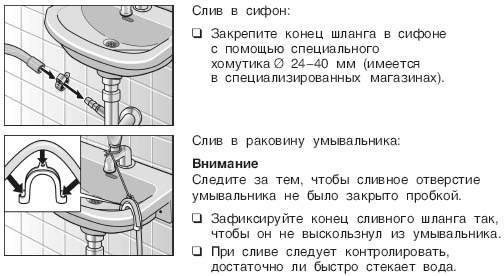
The main ways of draining the water are two - in the sink (bath) or through the siphon
For home-based craftsmen who are eager to do everything as well as professionals, the three remaining ways of mounting are more suitable. It remains only to decide where to connect the drain of the washing machine - immediately to the sewer pipe or through the siphon.
Using a sink sink
Under any sink there is a siphon, which creates a water stopper and prevents the sewer "ambre" from flowing into the room. It is to it that you can connect the drain of the washing machine.
Most of the branch pipes in the area from the sink to the bottom siphon tank already have a connector for connecting the stylus drain. By default it is closed with a cork. If it does not exist, you will have to buy a new siphon device and replace it with the old ones.
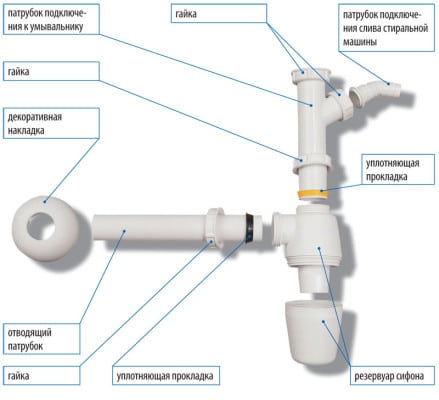
Wash-off siphon device layout
This method is inexpensive, simple and reliable. The main thing is not to forget to install a rubber cuff. Then unpleasant odors just do not break into the room.
Advice! Do not zealous with excessive silicone sealing. Full tightness of the connection can lead to sucking of dirty sewer water back into the washing tub. This is rare, but it happens.
The only drawback of this connection option is the gurgling of water in the sink when draining from the "styralka". Something to do with this is impossible. It remains only during washing not to use the washbasin.
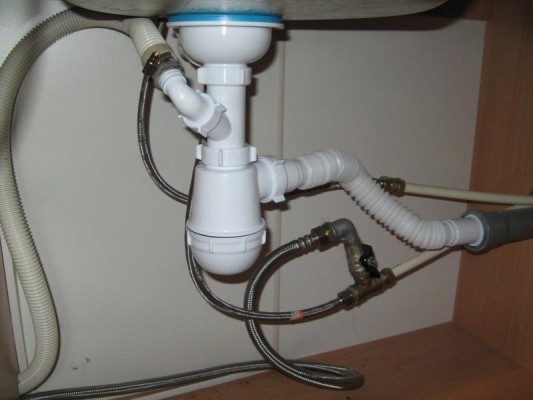
Connecting the drain to the wash-basin siphon
The pump that pumps dirty water from the machine is located at the very bottom of the unit. On the back panel there is a special fastener for the drain hose at a height of 50-60 cm from the floor.
The connection point of the branch pipe with the siphon pipe must be below this half meter. The bend of the hose in the shape of the letter "S" is the only correct circuit Connect the drain of the washing machine to the sewer system through the siphon of the sink. This is the only way to minimize the risks of leaks and the flow of water from the tank.
Installation of a special siphon with a non-return valve
Most modern instruments are equipped with a special drain valve. It prevents the sewage water from being drawn back into the tank with laundry and the consequent flow of it from there. But old or very cheap models of "washers" do not have this locking device.
There are siphons with a special check valve, which is built into the branch pipe, where the drain of the washing machine is connected. When connected through such a siphon, many problems can be avoided, and it will be inexpensive.
Mounting the drain directly into the sewer
Connect the machine to the sewer will be obtained without using a siphon, by direct connection to the sewer pipe. However, you will need the skills of installing plastic pipelines and the appropriate tools.
To connect a washing machine in this way you need:
- tee in the form of the letter "Y";
- rubber seals and cuffs;
- plastic pipes for branch installation.
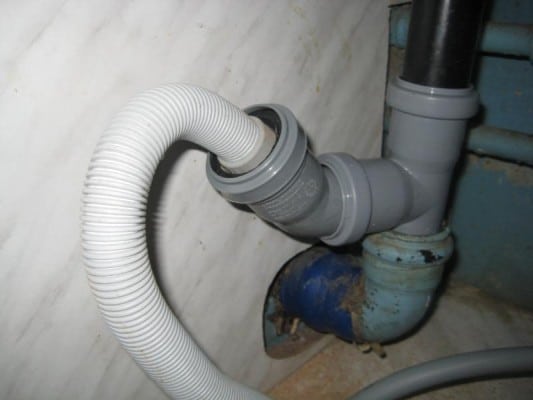
The installation of the tee below the siphon is simple and effective method
The simplest version of this connection is the installation below the siphon of the tee washbasin with a branch for the sink and for the "stylalki." Here the following installation rules apply:
- The sealing of the joint must be incomplete (rubber seals are enough).
- The end of the drain in the sewer pipe should not be in the water.
- The hose should be bent by the letter "S" to create a small water stopper inside.
- The entry point to the sewer should be above the exit point of the machine (for devices without a check valve).
If the washing machine is installed far from the sink, it will be necessary to lay a horizontal branch from plastic sewer pipes. At the approach to the device, it is necessary to make a bend at a right angle and a vertical rise of 30-50 cm.
Common installation errors
When performing any installation works errors are possible. It is necessary to know the problem places and not to allow the washing machine to connect to the sewerage of the malfunctions, otherwise they will have to be corrected anyway.

Inside a hydraulic seal must be formed
Four mistakes novice masters:
- No fixation of the drain hose. When you squeeze the water out of the device comes under pressure. If the drain is not fixed, it can be pulled out of the sewer by pressure and the flood is then guaranteed.
- A small siphon. Each siphon device has its own capacity. If it is narrow and thin, there will be problems with draining the water. She can go up into the sink. Kind of dirt in the washbasin is unlikely to please.
- The hose is too long. Pump "stilalki" may not cope with the pumping of water on a long sleeve from the machine to the sewer. As a result - breakage and blockages.
- Shallow shell and sink on its side. A large head can cause overflow of water over the edge. When organizing a drain without a siphon, it is better to hang the hose on the bathtub, rather than on the washbasin. In extreme cases, a toilet.
Video: connection of a washing machine to a water supply and sewerage system
To most correctly connect the drain hose of the washing machine to the sewer, it is necessary to observe a number of simple rules. Everything is simple enough. The main thing is not to think too much and follow the instructions. Experienced plumbers know all these subtleties, but for a beginner home master It is worth to consult with experts before starting the connection.
Connecting a washing machine with your own hands is not technically difficult, but it's quite a responsible thing. And the fee for irresponsibility is expressed not only in money. The probability of electric breakdown in a washing machine is several times higher than in a dishwasher and is on the verge of acceptable for household appliances. And the capacitive leakage currents in it are also great, and the release of heat during operation is significant. Therefore, for long-term safe operation machines should be properly prepared for her workplace. This can be done both independently and with the involvement of specialists. And the right choice depends not only on your desire and / or ability.
Everything depends on the grounding
Solid trading organizations often include the cost of installation on site in the sales price. It seems that it's not bad either; The surcharge itself is small, once the matter is put on stream. But, firstly, the "steep" firms "steep" are trading - you will not find budget models there.
Secondly, such traders do not deal with the protective earthing device; it must be equipped in advance, otherwise the company refuses from the installation (but the surcharge to the price does not return), and immediately the guarantee is lost. You got an expensive assistant, a branded master came, saw that there was no ground, wrote an "internal" act - and that's all, you are without a guarantee and without a lot of money.
But even if the car is purchased from a "simple" seller without any special conditions, but later it turns out that it was operated without grounding, you will be refused warranty repair. In the instructions for installing any washing machine in black and white it is prescribed that its operation without grounding OR protective devices is unacceptable. OR it is not in vain, we'll talk about this later.
Conclusion: installation of washing machines with their own hands is quite possible, if it is provided in advance.If you buy an expensive brand in a solid trading company, then if you have a ground, you will install it for a ridiculous price, compared with the private owner, with full preservation of the guarantee.
Kitchen, bathroom or closet?
Before discussing the paramount importance of the issue - the grounding of the washing machine, you need to decide no less important: the place to install it.
The washing machine is a rather powerful source of heat and humidity. And next to it there must be an electric socket. Her contacts are covered with a lid for you, but for air they are bare. Therefore, it is not recommended to install an automatic washing machine in the bathroom, where humidity is always excessive,
- The installation of household electricity distribution and switching devices in the bathroom is strictly prohibited by the SNiP (Building Regulations and Rules). Have you ever seen a switch in the bathroom in a new home? Only outside, and the lamp is waterproof. Given the widespread prevalence of automatic machines, electricians are still looking at it through their fingers, but with their teeth tied: household electrotraumatism from washing machines in the bathroom has long exceeded the permissible limits. The grounds for introducing additional legislative measures are undeniable, but prohibited by law, but not by departmental rules - fines will be levied; the owners also have expensive repairs.
- Even if the electrical cord from the stylalk is out of the bathroom (the warranty is lost from its build-up), then in the machine itself there are enough nodes whose durability from increased humidity and air temperature is reduced.
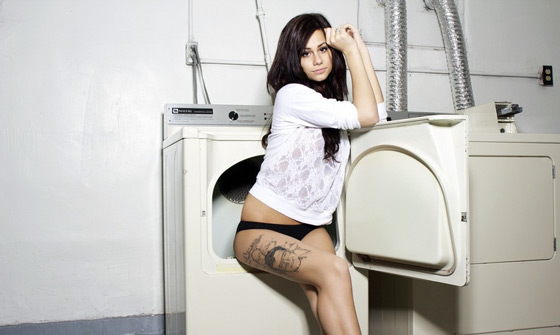
Most users are fine and they themselves understand this, and most often put a washing machine in the kitchen. At the same time it is easy to connect to water, sewerage and electricity. But the temperature-humidity problem remains. And often you have to choose: washing or cooking. In addition, there is not enough room in the kitchen and so there is no room, and the room is the most visited in the house.
But if you have a closet adjacent to the bathroom or kitchen - this is the perfect place for styralka. Punch holes in the wall under the communications for the machine - it's a simple matter, no reconciliation is required - the wall between the closet and services can not be capital. In the closet they almost never go in, it's dry and cool. And with an open door, a working styalka itself will create in its small volume an intensive air circulation.
In figures, it looks like this: if we take the average failure rate of washing machines installed in the kitchen for the base model, then the frequency of machine breakdowns in the bathroom will be 2.4 times higher, and the "shackled" - 1.7 times lower.
Note: atprestigious houses of the Soviet era, the so-called Czech project, it was stated in the technical description that the adjoining closet is primarily intended for installing a washing machine and domestic hot water appliances. At the time of communal tariffs this was perceived as a curiosity.
Protection against breakdown and electricity leaks
For a washing machine, protection against leakage currents is more important than breakdown. Modern household appliances are generally reliable, and direct "babas" with smoke, stench and resuscitation - an exceptional phenomenon, yes, because of the carelessness of the owners.
But the electric capacity of a large tank with several dozen liters of water and a large powerful motor is quite high: up to 0.01 uF in older models. At 50 Hz in the 220 network, the capacitive leakage current will be 0.7 mA - this is still a safe, but already palpable pinch, especially through wet hands in a humid room.
For readers familiar with electricity within the school physics course, the data presented may not seem very reliable, but note: they concern a filled machine, and water is an abnormal liquid, its dielectric constant is very high: 80.
The leakage current does not interfere with the machine's work, its reliability does not decrease, but it is impossible to prevent it, it can only be taken to the ground. An increase in the leakage current beyond the permissible level is an explicit signal of a maturing malfunction. That is why washing machines are forbidden to operate without protection for electric leakage.
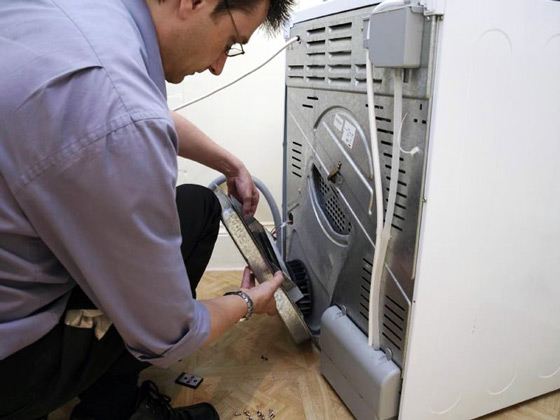
Aquastop and aqua-control
The major part of the leakage current goes through the drained water. Drain is also the main source of water leakage. Therefore, manufacturers recommend acquiring aquastop devices (another name is aquatic control), which shut off the machine in case of an electrical and / or water leak. Solid manufacturers complete their cars with aquastops.
Complex akvastop requires a separate power supply. A box without a power cord and a low-power low-voltage power adapter is a primitive check valve that does not protect against electrical leakage, and protects poorly from water leakage.
Electronic grounding
AT apartment buildings it is often difficult, if not impossible, to arrange an individual protective earthing, on the one hand. On the other hand, manufacturers are not asleep: fighting leakage currents is one of the most important tasks of brand designers.
In modern serviceable washing machines leakage to the case does not exceed 10-12 μA, which is insensible. But in a pre-emergency situation, it increases dramatically. For such a case, so-called. electronic grounding (automatic protection devices, automatic cut-off devices). They pass through a leakage current into the space, like a human, and when it increases to a measurable limit of 0.1-1 mA, the machine is disconnected from the network.
With the undoubted merits of electronic grounding, there is a significant drawback: its sensitivity is highly dependent on the parameters of the air in the room. Electronic grounding can obstinately disconnect an absolutely fault-free machine.
Any electrical devices 90% of faults occur when on / off, so some manufacturers prohibit the operation of their products with electronic grounding. So when buying a car, be sure to ask the seller if the warranty will not be lost from using an electronic grounding.
Typical grounding scheme for modern PUE:

Protective ground
But the mistress beats and frightens the electric leakage not through the water, but on the body of the car. To eliminate it, you need a protective earth. His type depends on the house:
- In a private house, the technically ideal option is the simplest protective earthing, see below. It does not need to be registered: in a disputable situation, the expert will check the current flow resistance, and if it is not higher than 4 ohms, which is not difficult to provide, the solution will be in your favor.
- In the multi-apartment buildings of the previous years, from the Khrushchev to the perestroika, a full protection will be given by protective zeroing. His for a small fee quickly and willingly make a DEZovsky electrician.
- In old houses up to "stalines" inclusive, if the house ground loop is not equipped, it is necessary to put an electronic grounding.
- AT modern houses The problem of grounding does not exist: according to the new building rules, they are necessarily equipped with a ground loop and Euro-sockets. In addition to illegal samostroya to eat "with signs of multifamily", as they say. But this is another topic.
How to make a ground connection yourself:
This requires 2-4 segments metal pipe length 1,2 - 2,5 m, but not shorter than the depth of freezing of the soil. The bottom of the pipe is driven by a sledgehammer to the stake, and a third of holes of 5-10 mm are drilled in its lower third. Then, dig a trench on the spade bayonet, and drive the pipes to 5-10 centimeters protruding above the ground, at a distance of 0.6 - 1.5 m from each other. In the trench, below the ground level, the pipes are joined by the armature on welding. It is welded to it and a steel wire of 6-8 mm or a strip of 15-25 mm is turned into the house - it is a grounding bar; to its stranded copper wire in 4-6 square meters connect the ground terminals of the sockets. For this purpose, holes are drilled in the strip and threads M4-M6 threaded into them; The wire is pre-spilled. Place the seat under the earthing switches from the sockets with a skin and grease with a grease; better - graphite.
Note: In summer, when the soil dries up, a salt solution is poured into the pipes, from the calculation of the half-pack to the bucket. This is necessary to ensure the flow of current in the dry soil. With an outside temperature of +35 degrees, fill in once a week; at +30 - once a month.
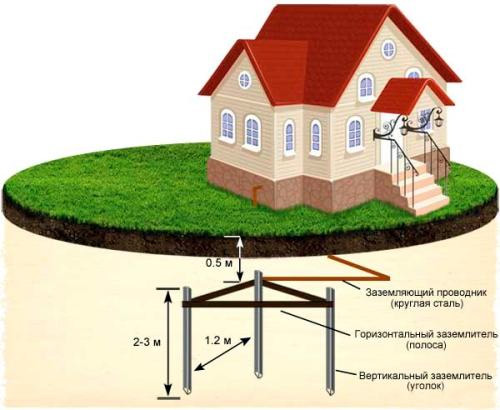
Grounding scheme for a private house
Installing the washing machine
Installation and correct connection washing machine is produced in the same sequence as the dishwasher: drain, water, electricity, test. But there are features:
- In a large and voluminous stylalka, the phenomenon of so-called " temperature hysteresis of the automation. Therefore, if a boiler, electric or gas is installed in the house, the total cost of water and electricity will be lower if the impeller is supplied hot water From him. For a small dishwasher with negligible water consumption, the situation is reversed.
- The connection to the mains power also includes protection measures, and the protection is done first of all.
- Stiralki very quickly wear out and break, if their inclination in any direction exceeds 2 degrees, and absolutely do not endure resonant vibrations. Therefore, the floor under the stylalko should not play, and before checking the performance horizontality of the top plane of the machine check level, and level the machine with regular threaded legs.
Note:on sites with suffix.kz you can meet the recommendations to connect the washing machine to the centralized hot water supply. Perhaps in Kazakhstan they still serve hot water without a counter on the old Soviet tariffs, but in the Russian Federation this advice is unacceptable.

Draining
The connection of the washing machine is super narrow, narrow or compact, it is made into a siphon with an additional chimney kitchen sink. But in this case the styralka should stand side by side: it is impossible to increase the drain hose. In low-productivity machines and drain pump is low-power, in addition the hydraulic resistance of the long hose will overload it and it will quickly fail.
Drain high-performance machines with a tank capacity of more than 30-40 liters a kitchen siphon does not miss all - dirty water will partially go into the sink. In this case, you need to connect the washing machine to the sewer with a separate tap. For this, it is necessary to cut into sewage pipe an additional section with a branch pipe, and draining the washing machine through a separate siphon (see the figure above).
Important: The knee of the styrofoil siphon should be located below the bottom of its tank. In most cases, for this you have to put the machine on a stand with a height of 30-40 cm. Take this into account when choosing a place for a washing machine.
Note: a compact washing machine can be installed in the kitchen, on a shelf or, if there is a place on the table, or carry it there. In this case, the sink will simply go into the sink. Such machines are often equipped with water hoses with a bell and a cuff, put on the faucet of the kitchen sink.
Water
As indicated above, the connection of the washing machine to the water pipe is carried out both on the cold and on the hot branch. There are no special features here, just two half-inch water tees, two stop ball valves and a FUM tape for waterproofing: the pipe ends of the complete water pipes often turn out to be too short, and the standard gasket has to be thrown away.
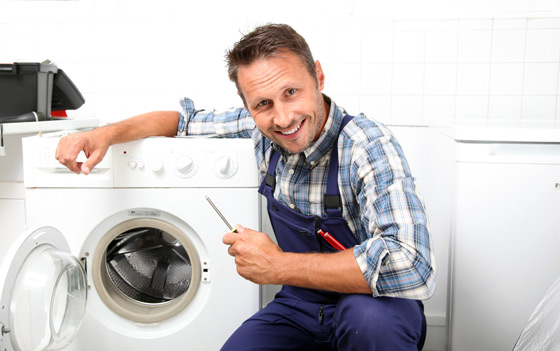
Protection, electricity and verification
First of all, we install the aquastope on the drain hose, according to the instructions to it. Then we turn on, if necessary, electronic backing. This device is equipped with a European outlet, into it and turn on the washing machine. In the presence of "earth" protective earth connection of the washing machine to the mains power is reduced to insert the plug into the socket.
We open the water supply to the machine, check the pipelines for leaks. If somewhere flows - we eliminate. Then we turn on the machine for test mode; at the end of the test, it must turn itself off and tell the display that everything is OK. If the machine is inexpensive and without a built-in test - just erase anything, but the water flow will be more. The final stage is to cover hot water in the machine, and we check, by test or washing, work on self-heating.
Important: devices of akvastopa and electronic grounding do not duplicate each other; they must work together. In the presence of a dull protective pinch, an aquastope is still necessary.
In order for the washing machine to work for a long time without breakdowns and "do not beat the current," it must be installed in a suitable place and provide a reliable protective earth. In the rest self-installation washing machine is not difficult.
Video: example of installation of a washing machine by a specialist
To install a washing machine it is not necessary to call a master whose services will not be expensive. Using the recommendations of the manufacturer, how to connect a washing machine yourself, you will be able to correctly implement all the necessary manipulations with minimal financial costs.
First of all, you need to think about the place where the unit will be installed. Modern models that require connection to water and sewerage, have a stationary placement, since their transfer is very difficult.
When determining the location of the machine, it is necessary to take into account factors such as:
- available near the water supply and sanitation system;
- possibility of easy connection to the mains (preferably not through an extension cable, but directly);
- the presence of an even (better reinforced) floor;
- a harmonious combination of the washing device with the interior of the room;
- free access from all sides: in addition to easy loading of laundry, it is important to have a clearance from the side of the wall so that you can get accidentally dropped underwear or another object.
In practice, washing devices are usually put in the bathroom, in the kitchen or in the corridor.
Bathroom. This is the traditional location of the machine, as in this room, which has all the necessary communications, it is easy to equip a drain and supply water.
The disadvantages of this option include the miniature size of most bathrooms, which is why the owners often have to choose compact models. In addition, for such spaces is characterized by high humidity, which can affect both the state of electrical wiring and the health of various parts of the "washers".
Kitchen. This room is also often used to mount the unit, which is usually installed under the sink or next to the sink. Since this room is usually also small in size, washing here sometimes hinders the owner. In addition, the temperature and humidity conditions in the kitchen also do not always correspond to the rules for the operation of washing machines.
Automatic typewriters are often used in kitchens. In this case, both built-in and conventional models can be used
Entrance hall and other office space. An unusual, but quite acceptable option is to install an automatic device in the hallway, closet, utility room or even a spacious wall cabinet. The only obstacle in this case may be the lack of easy access to communication systems.
The purchased machine is delivered to the apartment in a packed form. All rotating parts are fixed by fastening elements (bolts, bars, staples), which protect the device from accidental damage during transportation.
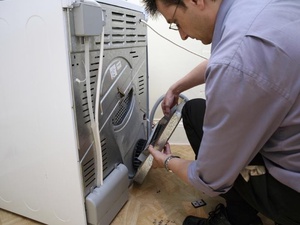
Before starting the installation, it is important to remove all fasteners (bolts, clamps, clamps) that protect the machine parts during transport
The imported "styralku" should be released from the box, after which it is necessary to remove the fixing parts:
- From the rear wall of the unit you need to remove the clamps, which are installed for the rigidity required for the transport of household appliances. Similar elements are also held by the flexible parts of the structure, namely the hose and electric cord.
- After this, it is necessary to remove the bars laid between the tank and the body of the device. To do this, it is enough to tilt the "stick" forward slightly.
- It is also necessary to remove the bolts that are installed on the front of the machine to fix the drum. In the holes from the removed elements, it is better to insert plastic plugs immediately (they are usually included in the model kit).
The released fasteners must be carefully packed and stored: they can be used when contacting the customer service.
Steps of connecting the machine
To start the operation of the washing device, the following steps must be performed correctly:
- align the device, giving it an optimal position;
- to connect to a water pipe for a water intake, necessary at washing;
- connect to the sewer to drain the water when implementing the set program (washing, soaking, rinsing, spinning);
- connect to the mains to ensure electric current, which drives the motor of the unit.
Aligning the washing machine
For the automatic machine to be used with maximum efficiency, its installation should be approached with the utmost care. Particular attention requires a floor foundation, which must meet a number of criteria:
- strictly horizontal surface;
- strong structure;
- sustainability;
- protection from vibration and other influences that are unavoidable in the operation of the unit.
If the basis does not meet this criterion, it is better to take measures to implement them. On fragile surfaces it is desirable to produce a cement-sand screed or to strengthen existing floors in the place of the alleged installation of a washing device.
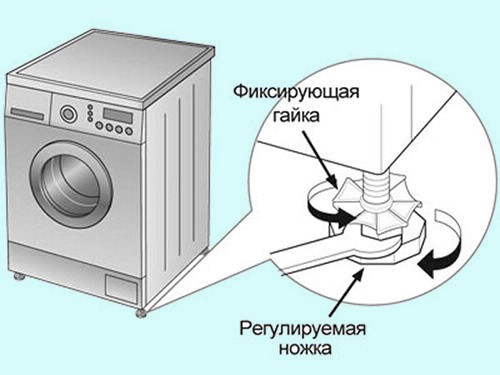
The diagram clearly shows how to adjust the height of the legs of the washing machine, which is necessary to give it an immaculately horizontal position
After making sure that the base meets all the previously mentioned requirements, you can proceed with installation.
Completely unpacked machine with the retracted fastening elements is put on the chosen place. On the upper surface, the horizontal orientation of the installation is determined, while the angle of deflection, which is verified by top cover, should not exceed two degrees. Exceeding this indicator leads to a sharp increase in vibration, which has a very negative effect on the condition of the nodes and significantly shortens the life of the machine.
Adjustment of the position of the unit is achieved by changing the height of the support legs: to increase the distance from the floor, they can be unscrewed, and to reduce - to screw.
It is strictly forbidden to put under them improvised materials that can slip out from under the supports during work, which can lead to the creation of an emergency situation. At the same time, it is allowed (and even recommended) to put a mat of fine rubber on a sliding tile surface.
As soon as the body of the machine takes an ideally horizontal position, tighten the locknuts counter-clockwise, fixing the optimum height of the support legs.
- the greatest degree of stability of the unit is achieved with maximally screwed up adjusting supports, but this option is only permissible for a perfectly flat surface;
- when installing the machine on an inclined floor for fixing supporting structures, it is advisable to use fixing parts;
- to check whether the unit is correctly installed, you need to try to swing it diagonally. If the process is done correctly, there is no free stroke or its amplitude is the same for different diagonals.
After verifying the correct position of the unit, you can proceed to the next steps.
Connecting the machine to the water supply
The most difficult and responsible part of the installation of the machine is its connection to the water supply system. To do this, you should:
- Evaluate the location of the unit to choose the connection method, on which the selection of hoses, fittings, fittings depends.
- When determining the necessary length of flexible pipes, it is important to consider that they should be placed behind furniture and sanitary equipment so that they do not interfere with walking.
- As a rule, complete with a machine hoses are offered, however their size is often insufficient. In this case, it is better to purchase extension cords that facilitate the installation.
- Required elements for connecting the "stilalki" to the water pipe is also a ball valve or a valve, the choice of which depends on the layout features.
Usually, the connection is made on the straight section of the pipeline, using a tee or a tube of the pipe, to which is attached a flexible connection from the toilet bowl. Sometimes it is more convenient to apply fasteners to the mixer (when pumping cold water to it). It is also possible to connect the unit by means of an additional mortise clamp.
Preparation of materials and tools
To connect to a metal pipeline, you will need gas and wrench wrenches, as well as gaskets - FUM tape or carded linen (preference is best given to the latter, since it swells under the influence of moisture).
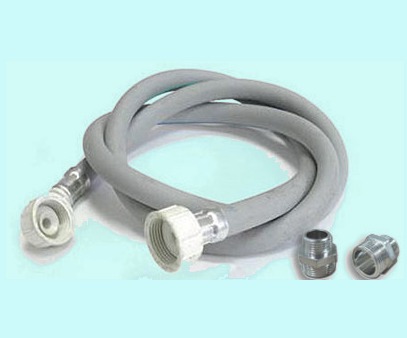
To connect the washing machine to the water supply system, you will need flexible hoses, fittings of different types, as well as all kinds of fittings
If we are talking about a sidebar to an internal water pipe made of polymers, we will have to use special equipment for soldering plastic pipes, calibrator, as well as special fittings designed for plastic and metal-plastic.
Having prepared everything you need, you can proceed directly to the connection of the washing machine to the water.
Fastening the hose to the washing machine
First of all, you must connect the enclosed or purchased separately hose directly to the unit. To do this, you should:
- in the end of the hose expose the filter (its convex edge should be directed toward the direction of the washing machine;
- tighten the nut in the place where the hose is fastened to the device. The tightening is done manually, the use of keys is undesirable. Rubber seals used for fastening, promote tightness of the connection.
After this, it is possible to start connecting the machine to the water source. There are several possible options.
Connecting the "machine" to the toilet
The easiest and quickest way to connect the washing device to water supply, which has become widespread. Instead of complex installation operations, it is enough to make a few elementary steps, even for a beginner.

The easiest way to connect the machine to the water pipe, using the toilet bowl. This elementary manipulation is easily performed even by a beginner
To connect, you must:
- remove flexible piping from the tube;
- wind the fitting-tee;
- connect to it a flexible piping from the tank and a hose for supplying water to the "stylalka" through the valve or shut-off valve.
Unfortunately, this option can not be used when installing a washing device in a separate bathroom or kitchen, because the automatic unit and toilet should be in the same room, preferably a short distance from each other.
Attaching the machine hose to the mixer
A popular option is also to connect the washing unit to the mixer, which can be used in almost any room.
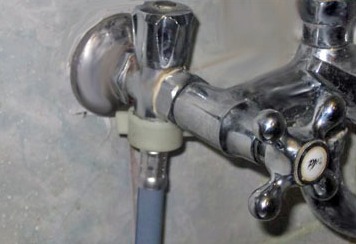
The water supply to the unit can be ensured by connecting the machine to the mixer. This is a fairly easy way, which can be applied not only in the bathroom, but also in the kitchen
For this method, a special version of the tee is required, the design of which provides for an integrated ball valve. This part is installed in the space between the cold water supply tap in the mixer, cold water to the same detail.
This method is reliable and simple, but it has a significant disadvantage, because the hose, by which the water pipe is connected to the "stick", is always in sight. You can hide it by arranging a box with the subsequent finishing with tiles.
Cutting into a plastic or polypropylene pipe
The connection of the "automatic machine" to the communications from the metal-plastic can be done almost anywhere. To do this, it is sufficient to cut the pipe by installing a metal tee in place of the cut, thanks to which it is possible to make a branch of the communication to the washing unit.
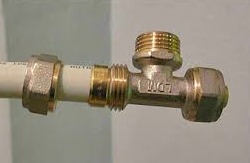
It is also possible to connect the "stylalki" to the metal-plastic pipe. To do this, a special fitting is installed on the pipeline section, to the end of which a hose
To perform this operation, you must take the following steps:
- cut the pipe;
- measure the parameters of the fitting (tee);
- cut off a piece of pipe corresponding to the adapter;
- fasten the connecting ring to the nut;
- with the help of a special tool - calibrator - to expand the ends of the pipe in the places of connection with the tee;
- put the pipe on the fitting fitting;
- push the O-rings from both ends, then tighten the nuts tightly.
The shut-off valve to the adapter must be screwed in advance, before the start of the frame. This will avoid damage to the elastic enough metal-plastic pipes. After the connection of the tee is complete, flexible water hoses are fastened to the screwed tap.
If the apartment has a plastic pipeline, you will need a complicated version of connecting the "stilalki". In this case, not only special fittings, but also a special tool, which allows soldering of pipe fasteners with adapters, is needed to perform the installation work.
In this case, a tee is installed on the cold water pipe, to which a hose connected to the "automatic" is connected through a shut-off valve.
Connection to water supply in any place
In some cases, it is convenient to connect the washing device to a specific location in the straight pipe. To perform this operation, you will need a special adapter - a coupling saddle, which is a clamp from the clip with a threaded tap.
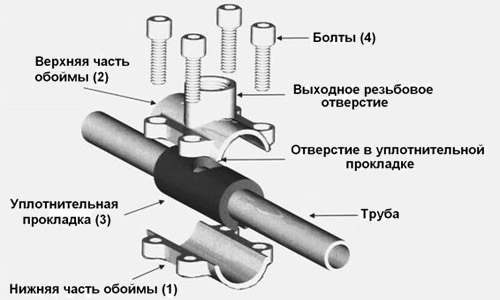
This figure shows a schematic representation of the coupling-saddle, by means of which it is possible to connect the automatic machine practically anywhere in the straight pipe
You can buy a similar element at specialized outlets, and it is important to pay attention to the diameter of the fitting, which must match the size of the pipe.
An integral part of the saddle is a collapsible cage: its construction is assembled on the pipe at the point of connection of the "stylalki" to the water supply, and it is important to use a reliable gasket.
The adapter firmly fixed on the desired fragment blocks the flow of water. After that, a hole is drilled through the branch pipe of the saddle. A valve (ball valve) is wound on the coupling outlet, which is used to connect a hose that supplies the washing machine with water.
For greater comfort during operation, it is also possible to connect to the crane unit.
Use of "automatic machine" in the absence of a water pipe
The operation of automated washing devices is possible in the case of water supply under pressure. The lack of a water pipe in a dacha or in a private home does not mean abandoning the usual amenities, because in this case you can use an alternative solution.
To use a modern machine, it is enough to lift a volumetric water tank to a certain height (at least one meter), to the bottom of which you need to connect a hose leading to the corresponding outlet of the unit. Water in the container should be poured in a timely manner.
Cardinally solve the problem with the help of a purchase pumping station. However, because of the high price, this option is usually considered for permanent residence in a house without water supply.
Connection to sewerage systems
Connecting the washing machine to the sewerage system allows to solve the draining problem dirty water, which remains after washing. You can do this by applying different schemes:
- Temporary, by using a special hose, sent to the toilet or bath.
- Constant, providing a device for stationary drainage.
The first method is very simple: drainage of water is made through a hose that is attached to the edge of the bathroom, toilet bowl or sink, which can be done with the help of special fixing elements.
In the second case, two options are possible. The discharge is carried out with the help of a siphon of special design, in which there is a separate tap for connection of "automatic machines", placed under the siphon bend. It is not necessary to replace a similar device with a conventional analog, since it will hold back the waste water, spreading an unpleasant smell.

This diagram shows the option of connecting the "automatic machine" to the sewage system using a siphon of a special design, which provides a special hose outlet
The washing machine can also be connected without a siphon. With a sewer pipe diameter of 4-5 cm, the branch for the machine of the machine can be connected directly to this element.
In this case, the S-curved drain hose is inserted into the pipe so that it does not touch the sewage, and then is carefully surrounded by the seal and sealed. The distance from the inflection point to the floor should exceed 0.5 m.
The maximum length of the hose is usually indicated in the instructions accompanying the model. If you select a larger part, the load on the pump will increase dramatically, which can lead to unforeseen breakdown.
If the design of the washing unit does not provide a check valve, then when mounting the model, there is a restriction on the height on which the drain hose is located. Specific information the manufacturer, usually leads to the manual.
Features of connection to the electrical network
Specific information on how to correctly connect the newly purchased washing machine to the electrical network, you can read the instructions. Special attention it is required to pay attention to safety rules, since the device has a high level of power consumption (1.5 - 2.5 kW), and also comes into contact with water.

To connect the unit to the mains it is important to carefully select the outlet. The device must necessarily have a ground, in addition, it is desirable to choose a model with a cover
As a rule, a three-wire socket is needed to connect the washing machine manually, in which there is a phase, zero and a carefully insulated ground wire. The distribution board is grounded by using a special busbar with a cross section of at least 0.3 cm.
When connecting, it is advisable to follow several recommendations:
- Optimal option - individual power supply. In this case, the "washer" is fed from the switchboard by a separate input, and the power is supplied via the additional power cables that are laid. That the wires do not spoil the interior, they can be placed in neat plastic boxes.
- Application of specialized electrical protection devices. In addition to the mandatory automatic switches It is recommended to install a residual current device (RCD) in the power line of the machine.
- Strict conformity of all components of electrical circuits to the required technical / operational characteristics. For conducting wiring it is important to use three-core cables, while the cross-sectional area should exceed 1.5 cm2.
- Connect the socket according to the scheme specified in the instructions. It is important to observe the mandatory condition - the presence of a protective earth. The connection of the wire is mandatory to the grounding bus of the switchboard.
- Connecting the conductor to heating or water pipelines is strictly prohibited, as this can lead not only to the failure of the machine, but also to the creation of emergency situations.
- When choosing models it is better to give preference to rosettes having a high degree of safety; it is desirable that they have a lid protecting from moisture and a ceramic base.
- When connecting the washing machine, extenders, tees and adapters should be avoided: the additional connections that are inevitable in this case may cause a temperature rise in the contacts, which leads to a breakdown of the unit.
It is undesirable that the outlet for the machine is in rooms with a permanent high humidity. If the length of the electrical cord is sufficient, it is better to place the supply device in an adjacent space, for example, a corridor.
Checking the operation of the machine in all modes
After completing all the above work, you need to check the correct installation.

The final stage of the work is to check all systems of the washing machine. It should be carried out strictly according to instructions and affect all aspects of the connection
To do this, you need to inspect all the assembled nodes, and then run a test run of the machine without laundry, during which you need to pay attention to the following options:
- period of time (it should be small), for which the tank is being recruited;
- absence of leaks;
- correct operation of the drain;
- uniform rotation of the drum;
- good spin;
- full-fledged heating of water, which is produced after 5-7 minutes after the completion of water recruitment.
At all stages of the unit operation, there should be no extraneous sounds.
The presented roller explains in detail the process of connecting the unit to the water supply, electricity and sewerage.
Exactly following detailed instructions, how to connect the washing machine to all communications with your own hands, with the installation of household appliances can be handled quickly and easily.




